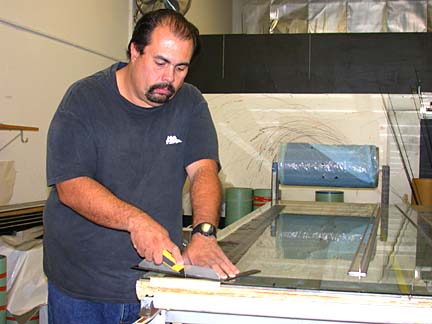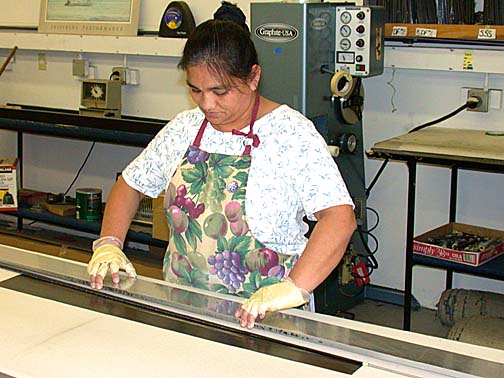
Graphite USA Super Spin Stick for Baja
![]()
|
Graphite USA 9-foot, 8.5-ounce Baja Super Spin Stick prototype, casts a two-ounce weight, 95.5 yards. |
A HIGH PERFORMANCE SPINNING ROD BUILT ON A GRAPHITE FLY ROD BLANK
By Gene Kira, Oct. 17, 2001, as published in Western Outdoors Magazine:
Although it is possible to spend well over $500 for a production spinning reel and over $200 for a semi-custom rod, like Rodney Dangerfield, spinning tackle just "don't get no respect."
Why should this be so?
Probably, the "left-handed coffee grinder's" biggest sin is that it's so ludicrously easy for beginners to use. How can any self-respecting "Angler" aspire to something that any semi-coordinated ten-year-old can learn in half an hour?
|
|
Recently, I was practicing my cast (yeah, my spinning rod cast) on a deserted middle school football field, and this kid walks up. Cute, freckle-faced kid, looking just like Huckleberry Finn.
"Whatcha dooon?"
"I'm seeing how far I can cast with this spinning rod."
He edges in a little closer.
"Can I try it?"
"Okay, but watch out. I'm using a pretty heavy sinker."
This kid (turns out, he was in the fourth grade) flips the bail over, loads my rod with a tight circular backstroke, and whips out a 40-yard cast, right between the hash marks, on his first try.
Without even bothering to reel the line in, he hands me back my rod.
"Caught a 35-pound tuna last Saturday."
"Go away, kid. I'm busy."
Despite the ease of learning the basic techniques of spinning gear, it's second greatest "sin" is probably that true mastery is as hard to attain as with conventional tackle. I can almost guarantee you that kid didn't use a spinning rod on his 35-pound tuna.
|
Dick Katner and production manager Roy Hastings with high-tech carbon fiber tennis rackets, bicycle frame, and fly rod blanks. |
Spinning gear is quirky, especially when it comes to dealing with the ever-present line twist, and getting maximum performance from it requires a fair amount of practice and concentration. When most anglers suffer an incomprehensible, giant bird's nest or a snapped off lure, or perhaps they lose a fish when a twisted line loop wraps around a guide, they tend to write off spinning tackle as "dumb kid's stuff."
A few years ago, I was introduced to the very rarefied world of high-end saltwater fly fishing (talk about respect!) by Gary Graham of East Cape's Baja On The Fly guide service, and the seeming miracle of landing striped marlin regularly with 30-pound test lines, reels with no gears or anti-reverse mechanisms, and feather-light rods weighing only about 8 ounces, got me to thinking about my "old faithful" spinning tackle.
|
Paul Branham cuts panels of graphite fabric that will be rolled on a precision mandrel and cured to form the blank. |
What might lightweight spinning gear be capable of, if given the respect enjoyed by conventional and fly fishing tackle? And specifically, how much pure fun would a really, really good spinning rod be to use? Would it be the ultimate "kid stuff"?
Thus was born the quest for an ideal, "super spin stick," every bit as technically advanced and aesthetically satisfying as a "real" fishing rod, that could travel conveniently to fish in Baja, be effective in a wide variety of situations, and have a decent shot at landing any fish likely to be encountered.
An all-around Baja Super Spin Stick should be rated for about 20-30 pound line, and it should be able to cast lures from about 3/8ths of an ounce, up to about 4 ounces. It should have enough length and power to cast very long distances and stop big fish, yet be super-light so you can cast all day long without fatigue. It should be able to handle a one-pound jig or sinker for deep bottom fishing, and it should be sensitive enough to transmit the slightest vibration. Finally, this mythical Baja fishing super-rod should be very resistant to damage, and it should break down into several pieces so it can be tossed quickly onto the backseat of a vehicle, or be taken on a plane without cumbersome rod tubes.
Obviously, nothing in this class is available off the rack, and neither had I ever heard of a custom-wrapped rod that could satisfy all of these requirements.
In order to get advice on the all-important rod blank, I called on Dick Katner of San Diego's Graphite-USA. Katner's company specializes in the design and manufacture of carbon fiber blanks for the high-end flyrod industry, and he is an experienced composite materials engineer who has designed such things as a Tour de France-winning bicycle frame and parts for the SR-71 spy plane. He also proved himself a true gentleman by not laughing out loud when I asked him how he might apply his carbon fiber expertise and technology to the design of a dumb old spinning rod. (Graphite-USA's bare blanks alone retail for more than what you would normally pay for a custom-wrapped spinning rod.)
After a considerable amount of discussion on exactly what the "Baja Super Spin Stick" was supposed to accomplish, Katner came up with an adaptation of an existing 18-weight flyrod design. My new Baja fishing rod was built on a reed thin, three-piece, nine-foot long, carbon composite blank, of medium-fast action, armadillo toughness, and elephant strength. Like all Graphite-USA rods, the Baja Super Spin Stick is composed of very high modulus carbon fibers--but not quite the highest made. Katner designs his blanks with just enough fiber elasticity to avoid "exploding" when the rod is over-stressed. My rod also has Graphite-USA's double helical outer fiber pattern, which keeps the blank's cross-section from becoming oval when bent, and enhances its strength and sensitivity. Finally, the carbon wall of the blank itself is thicker than on some other high-end rods, and the whole thing is covered with a tough epoxy gelcoat-like pigment layer. (Although I cringe when I see him do it, Graphite-USA's production manager, Roy Hastings, is fond of laying a blank down on the blacktop driveway and standing on it to demonstrate its strength and finish toughness. Ouch!)
|
Edna Tacio rolls graphite panels onto a mandrel to form a flyrod blank. Each rod is individually cut, rolled, cured, sanded and coated. |
To get this prototype blank ready for testing, I took it to experienced rod-builder Jim Hernandez of El Cajon, Calif., and asked him to wrap it with high quality components in a standard spinning rod pattern: eight, single-footed guides plus a tiptop, beginning with a 30mm guide about 24 inches from the center of the reel seat. Jim produced a lovely piece of craftsmanship in about 48 hours, and we were ready to begin testing.
So, what kind of rod is this Baja Super Spin Stick?
First, it is physically the lightest spinning rod of its power I've ever heard of. Wrapped and ready to fish, with hypalon grips and Fuji guides, it weighs in at a mere 8.5 ounces. In comparison, my "old standby" fiberglass rod, while only 7 feet long, weighs exactly twice as much at 17 ounces. This slender rod is a true pleasure to carry, hold, and cast. It slices through the air like a Jedi light saber.
|
|
Second, it is the strongest and most resilient rod per ounce that I've ever used. Even though it is nine feet long, and only one-half inch in diameter at its base, it will lift 10 pounds of dead weight off the floor as it bends over in a complete arch, a rather hair-raising sight when one considers that this is a three-piece rod (and a damned expensive one, too!). According to Graphite-USA's Roy Hastings, this rod will not break at the joints. If you intentionally try to break it, some other part of the shaft will let go first.
Third, it is incredibly sensitive. It's hard to quantify such a subjective thing as "feel," but I can say that with this rod, it seems like you might be able to feel a big drop of rain if it landed square on the tip. It's that sensitive. Compared to it, my old rods feel like lengths of wet spaghetti.
Okay, that's all very nice, but what we really want to know is how far can this baby cast, right?
Well... for its first real test, I took the Baja Super Spin Stick out to the old middle school football field, with a selection of lures and sinkers. As a known starting point on reels and line, I spooled 20-pound Power Pro Spectra onto my "old faithful" Penn 6500SS spinning reel. Nothing fancy.
For finger protection, I added a 20-foot top shot of regular 20-pound nylon monofilament line (never, never cast a spinning rod hard with Spectra against your bare finger).
Standing on the goal line with an itty-bitty, one-ounce Luhr Jensen Stinger tied on, my first cast went way high and to the right, but it went 55 yards. The next ten casts were also high and to the right, as I learned just how much index finger pressure it takes to control a rod with this much power.
After about 30 casts, I was averaging 70-75 yards down the center of the field, no problem, but I still had to concentrate on finger pressure, or the lure would surely fly off high and to the right.
I switched to a two-ounce lead sinker, gave a mighty heave, and it again flew off toward the sidelines, way high and to the right, but it went over 70 yards, even at that wild trajectory. We were definitely onto something here.
Over the course of the next hour or so, including a few minutes to wrap my bruised finger in masking tape, I reached the 75-yard line, then 80, then 85, then 90, and finally a best mark for the day of 95.5 yards. Subsequent testing confirmed that the natural maximum range of this set up is between 90 and 95 yards.
|
Rod wrapper, Jim Hernandez, lines up guides for the Baja Super Spin Stick. |
Yes! It is a lot of fun casting a lure so far that you can't see it land, and this type of rod can open up a whole new dimension of Baja fishing for beginners and old timers alike. This is a tremendously versatile tool for anything from bottom fishing to beach casting.
However, it should be remembered that all this power can also be potentially hazardous. At the speeds generated by this rod, even a one-ounce sinker has the ability to injure severely, or even cause a fatality. Use caution, and beware of sinkers flying in crazy directions if the line breaks during the cast. Finger protection is essential. To avoid severe cuts, drags must be hammered down tight during the cast. At the end of these tests, I just couldn't throw anymore because of the bruises on my right index finger.
Finally, it's clear that a distance of 95.5 yards is nowhere near the limit for the Baja Super Spin Stick. During testing, it became apparent that the present guide pattern is completely wrong. I am now switching to a more modern reel design and the Fuji-recommended guide pattern (big at first, tapering to small at about the midpoint of the rod), which should allow casts of over 100 yards. While not an extraordinary absolute distance--the American tournament spinning cast record is 248.81 yards with special rods and techniques--to cast a two-ounce lure a distance of 100 yards with a general-purpose rod would be pretty danged respectable for any Baja fishing rod, even for spinning tackle that "don't get no respect."
|
Katner knows carbon. Graphite-USA's Dick Katner. |
(Related Baja California, Mexico, articles and reports may be found at Mexfish.com's main Baja California information page. See weekly fishing news, photos, and reports from the major sportfishing vacation areas of Mexico including the Baja California area in "Mexico Fishing News.")
MEXICO FISHING INFO BAJA FISHING INFO "WEEKLY MEXICO FISHING NEWS" FISH PHOTO GALLERY





